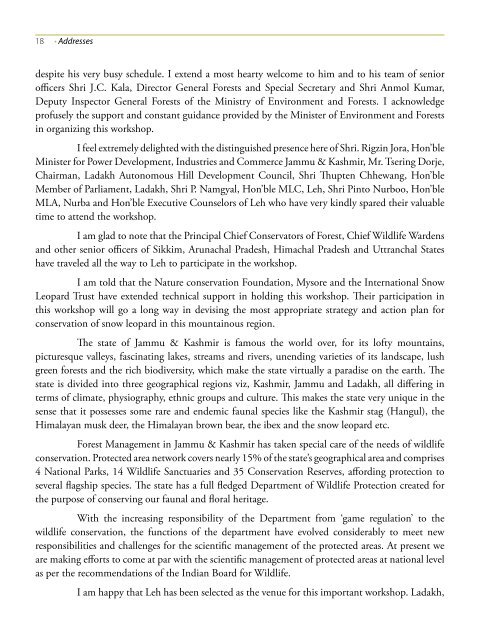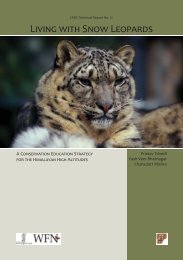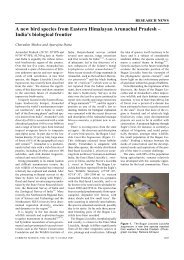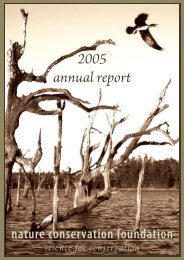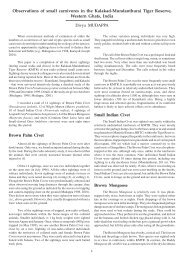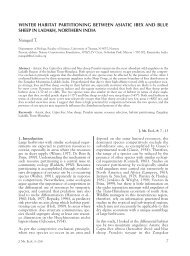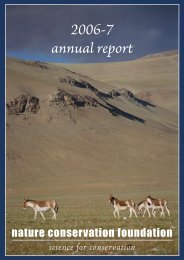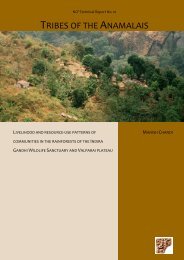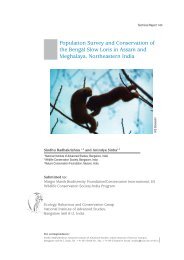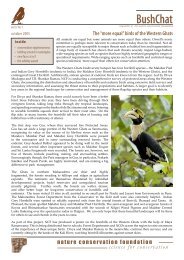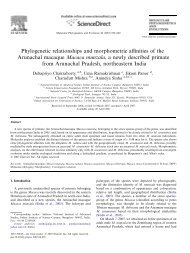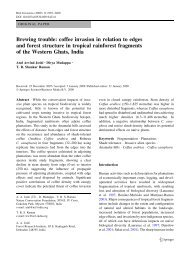towards project snow leopard - Nature Conservation Foundation
towards project snow leopard - Nature Conservation Foundation
towards project snow leopard - Nature Conservation Foundation
You also want an ePaper? Increase the reach of your titles
YUMPU automatically turns print PDFs into web optimized ePapers that Google loves.
18 • Addresses<br />
despite his very busy schedule. I extend a most hearty welcome to him and to his team of senior<br />
officers Shri J.C. Kala, Director General Forests and Special Secretary and Shri Anmol Kumar,<br />
Deputy Inspector General Forests of the Ministry of Environment and Forests. I acknowledge<br />
profusely the support and constant guidance provided by the Minister of Environment and Forests<br />
in organizing this workshop.<br />
I feel extremely delighted with the distinguished presence here of Shri. Rigzin Jora, Hon’ble<br />
Minister for Power Development, Industries and Commerce Jammu & Kashmir, Mr. Tsering Dorje,<br />
Chairman, Ladakh Autonomous Hill Development Council, Shri Thupten Chhewang, Hon’ble<br />
Member of Parliament, Ladakh, Shri P. Namgyal, Hon’ble MLC, Leh, Shri Pinto Nurboo, Hon’ble<br />
MLA, Nurba and Hon’ble Executive Counselors of Leh who have very kindly spared their valuable<br />
time to attend the workshop.<br />
I am glad to note that the Principal Chief Conservators of Forest, Chief Wildlife Wardens<br />
and other senior officers of Sikkim, Arunachal Pradesh, Himachal Pradesh and Uttranchal States<br />
have traveled all the way to Leh to participate in the workshop.<br />
I am told that the <strong>Nature</strong> conservation <strong>Foundation</strong>, Mysore and the International Snow<br />
Leopard Trust have extended technical support in holding this workshop. Their participation in<br />
this workshop will go a long way in devising the most appropriate strategy and action plan for<br />
conservation of <strong>snow</strong> <strong>leopard</strong> in this mountainous region.<br />
The state of Jammu & Kashmir is famous the world over, for its lofty mountains,<br />
picturesque valleys, fascinating lakes, streams and rivers, unending varieties of its landscape, lush<br />
green forests and the rich biodiversity, which make the state virtually a paradise on the earth. The<br />
state is divided into three geographical regions viz, Kashmir, Jammu and Ladakh, all differing in<br />
terms of climate, physiography, ethnic groups and culture. This makes the state very unique in the<br />
sense that it possesses some rare and endemic faunal species like the Kashmir stag (Hangul), the<br />
Himalayan musk deer, the Himalayan brown bear, the ibex and the <strong>snow</strong> <strong>leopard</strong> etc.<br />
Forest Management in Jammu & Kashmir has taken special care of the needs of wildlife<br />
conservation. Protected area network covers nearly 15% of the state’s geographical area and comprises<br />
4 National Parks, 14 Wildlife Sanctuaries and 35 <strong>Conservation</strong> Reserves, affording protection to<br />
several flagship species. The state has a full fledged Department of Wildlife Protection created for<br />
the purpose of conserving our faunal and floral heritage.<br />
With the increasing responsibility of the Department from ‘game regulation’ to the<br />
wildlife conservation, the functions of the department have evolved considerably to meet new<br />
responsibilities and challenges for the scientific management of the protected areas. At present we<br />
are making efforts to come at par with the scientific management of protected areas at national level<br />
as per the recommendations of the Indian Board for Wildlife.<br />
I am happy that Leh has been selected as the venue for this important workshop. Ladakh,


